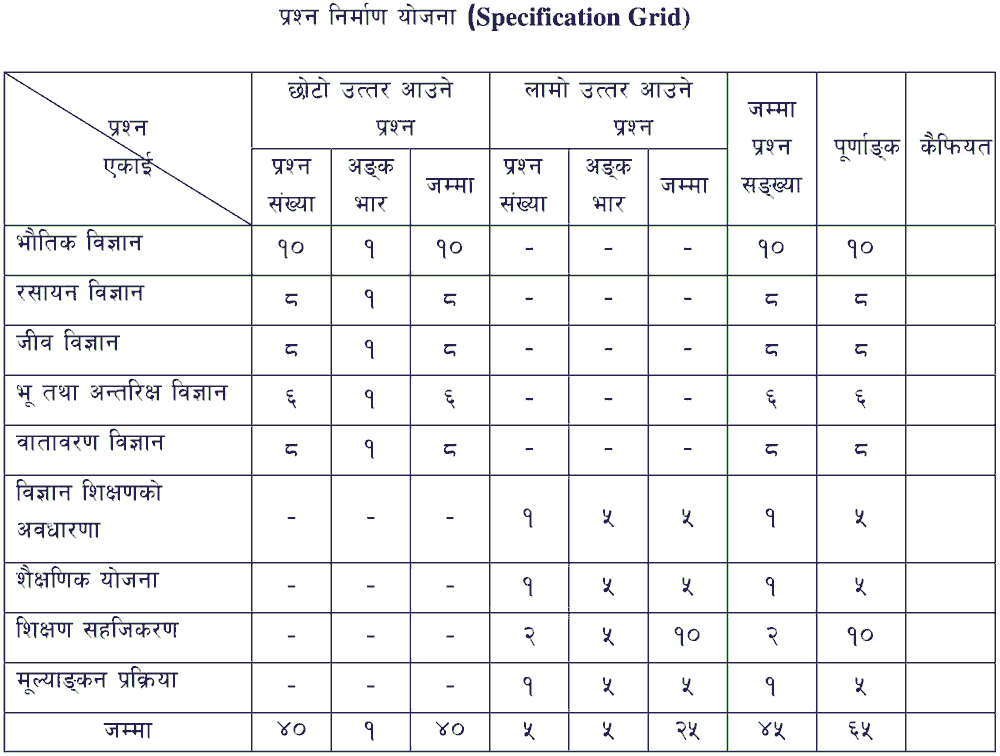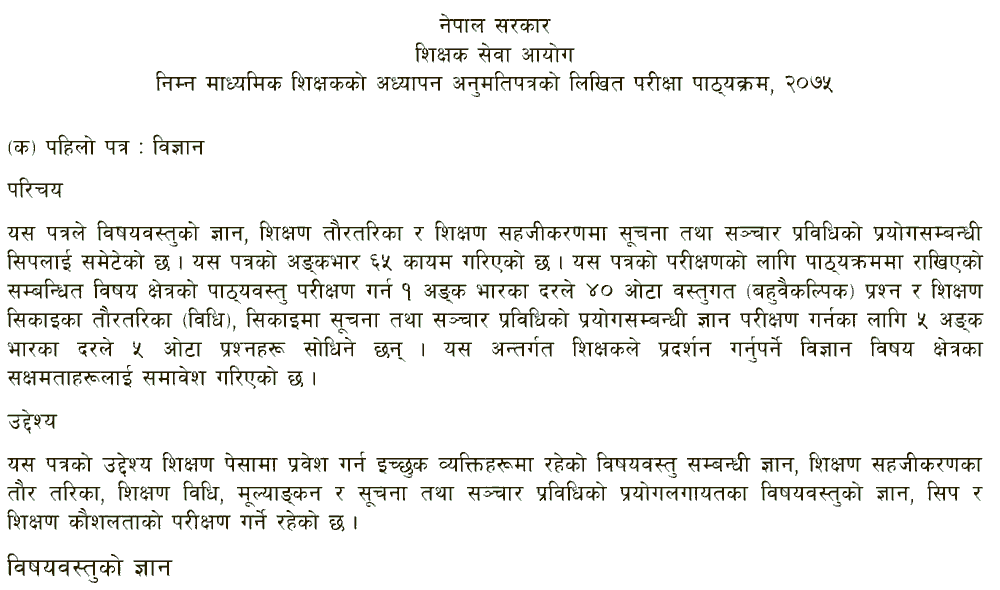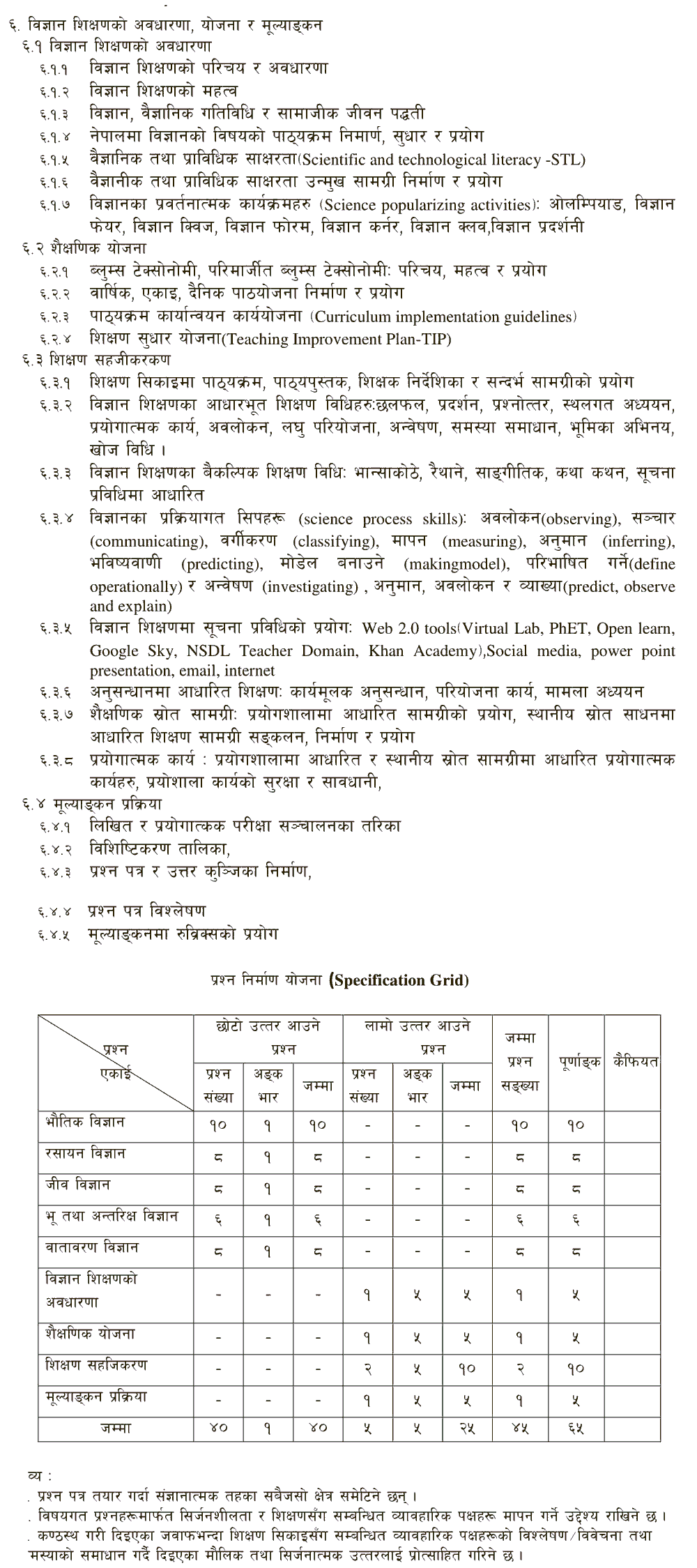

1. Physics
1.1. Unit and Measurement
1.1.1 Importance of measurement
1.1.2 SI Unit,
1.1.3 Fundamental and derived units,
1.1.4 Relation between FPS, CGS, MKS system,
1.1.5 Measurement of time, length and mass
1.1.6 Error in measurement,
1.1.7 Uncertainty and Significant Figures.
1.2. Simple machine
1.2.1 Introduction of simple machine
1.2.2 Type simple machine
1.2.3 Use of simple machine
1.2.4 Law of moment
1.2.5 Mechanical advantage, efficiency and velocity ratio of simple machines
1.3. Mechanics
1.3.1 Scalar and vector quantities
1.3.2 Newton's laws of motion
1.3.3 Conservation of Momentum
1.3.4 Verification of Newton's laws of Gravitation
1.3.5 Work, Energy and Power
1.3.6 Pressure in a fluid
1.3.7 Archimedes Principle
1.3.8 Atmospheric pressure (measurement and use)
1.4. Heat and Optics
1.4.1 Source of heat
1.4.2 Expansion of heat
1.4.3 Thermal expansion
1.4.4 Heat and temperature
1.4.5 Thermometry
1.4.6 Relation between Fahrenheit, Celcius and Kelvin scale
1.4.7 Specific heat capacity
1.4.8 First and second laws of thermodynamics
1.4.9 Reflection and refraction and light
1.4.10 Nature and propagation of light
1.4.1 1 Defects of vision and their correction
1.4.12 Phenomenon of polarization of light
1.4.13 X- rays and ultrasound
1.5. Sound
1.5.1 Free, damped and forced oscillation,
1.5.2 Longitudinal and Transverse motion of waves
1.5.3 Velocity of sound in air,
1.5.4 Effect of temperature, pressure, and humidity on the velocity of sound,
1.5.5 Principle of superposition;
1.5.6 Resonance,
1.5.7 Ultra and Infrasound
1.5.8 Sonometer
1.6. Electricity and Magnetism
1.6.1 Electric circuit
1.6.2 Dry cell
1.6.3 Series and parallel combination of cells
1.6.4 Household wiring
1.6.5 Fuse
1.6.6 Ohm's law
1.6.7 Electromotive force and potential difference
1.6.8 Faraday's laws of electromagnetic induction
1.6.9 Factors affecting resistance
1.6.10 Dynamo and transformer
1.6.11 Introduction of alternative current
1.6.12 Molecular theory of magnetism
1.6.13 Methods of preparation of magnets
1.6.14 Magnetic field and magnetic lines of forces
1.6.15 Dip and dip circle
1.6.16 Elements of earth magnetism
1.6.17 Dia-, Para- and Ferro-magnetic materials
1.6.18 Magnetic effect of current-Oersted's experiment
2. Chemistry
2.1. Language of Chemistry
2.1.1 Symbols and formulae,
2.1.2 Atoms and molecules,
2.1.3 Elements
2.1.4 Compounds.
2.2. Matter
2.2.1 State of matters: Solid, liquid, gas
2.2.2 Atomic Structure
2.2.3 Electronic theory of valency and bonding
2.2.4 Discovery of fundamental particles of an atom
2.2.5 Electronic configuration of the atom and ions
2.2.6 Octet rule
2.2.7 Ionic and Covalent bonds, ionic and covalent compounds, and their properties
2.3. Periodic Table
2.3.1 Mendeleev's periodic table,
3. Biology
3.1 Structures of plant and animal cell
3.2 Plant and animal tissues with their functions
3.3 Protoplasm and Chromosome
3.4 Mitosis and Meiosis cell division
3.5 Laws of inheritance (Mendalism), Mono-hybrid cross
3.6 Classification of plants and animals
3.7 General characters and classification of leguminosae, compositae, protozoa, porifera, mollusca and chordata
3.8 Metabolism: Photosynthesis, Respiration, Mineral nutrition
3.9 Structural and functional aspects of Pond and Forest Ecosystems
3.10 Interaction of biotic and abiotic factors
3.11 Ecological pyramids, productivity
3.12 In-situ and Ex-situ Conservation of animals
3.13 Bio-Geo-Chemical cycles: carbon and nitrogen
3.14 Physiological system of human (digestive, circulatory, respiratory, excretory, urinary, reproductive, muscular, skeleton, nervous system and glandular system)
4. Geology and Astronomy
4.1. Geology
4.1.1 History of the earth
4.1.2 Structure of the earth
4.1.3 Types of rocks
4.1.4 Green House Effect
4.1.5 Ozone layer and its importance
4.1.6 Climate change
4.1.7 Atmospheric layers
4.1.8 Natural disasters
4.1.9 Minerals
4.1.10 Volcano and earthquake
4.1.11 Water Cycle
4.2. Astronomy
4.2.1 Solar system
4.2.2 Galaxies
4.2.3 Lunar and solar eclipses
4.2.4 Birth and death of stars
4.2.5 Satellites'
4.2.6 Constellations
4.2.7 Identification of stars and planet
4.2.8 Heliocentric theory
5. Environmental Science
5.1. Balance of Environment
5.1.1 Concept of environmental education
5.1.2 Environment and its importance
5.1.3 Elements of the environment (Physical, chemical, biological, social/cultural)
5.1.4 Natural resources
5.1.5 Natural resources and human dependency
5.1.6 Environmental balance
5.2. Environmental Protection
5.2.1 Causes and effects of environmental degradation
5.2.2 Effects of human activities on the environment
5.2.3 Roles of NGO/INGO to protect the environment
5.2.4 Measures of environmental degradation
5.3. Environmental Pollution
5.3. 1 Global warming,
5.3.2 Greenhouse effect
5.3.3 Acid rain
5.3.4 Ozone layer depletion,
5.3.5 Air pollution
5.3.6 Land pollution
5.3.7 Water pollution
5.3.8 Noise pollution
5.3.9 Radioactive pollution
5.3.10 Pesticides
5.4. Sustainable Development
5.4.1 Concept of sustainable development
5.4.2 Indicators of sustainable development
5.4.3 Theory of sustainable development
5.4.4 Efforts of sustainable development
5.4.5 Biodiversity

Please Download Collegenp App from Playstore: Install Now for regular Update


